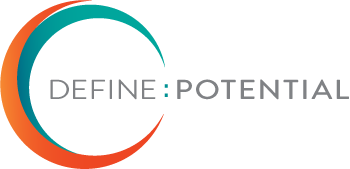Define Potential Blog
Wellbeing in the workplace – authentic relationships
6 May 2020

As an executive coach – I have noticed an emerging theme amongst my clients and colleagues. The theme is wellbeing.
Thoughts coming up from colleagues, clients, friends, or even in my own head over recent weeks include…
“I used to bounce ideas off my colleague who sits next to me several times a day. Now I can go for days in a row without speaking to him”.
“Priorities are changing quickly at work, and I’m not sure how I fit in with the rest of the team anymore”.
“My supervisor is always so busy, and it’s harder to know how best to engage with her”.
“I trust my direct reports, but I’m finding it difficult not having a line of sight on what they are doing each day”.
“I just don’t know how I am supposed to monitor my child’s schooling, as well as get my own work done, and hold the family together”.
“It’s really hard to keep myself motivated – I wonder how the rest of the team are finding it?”
Wellbeing: What does this have to do with me?
Wellbeing is more important than ever.
Organisations have long recognised the importance of supporting employee wellbeing, and the resulting positive impact on engagement and team performance. How do leaders prioritise their own wellbeing, as well as the wellbeing of their teams in our ‘new normal’? Let alone managing all the caring responsibilities and the wellbeing of loved ones…
Current struggles include many teams working from home and leaders finding it harder to stay connected. Team members may be feeling a bit adrift or ‘out of the loop’. Communication suffers – buffered by technology yet lacking in the hints that we get from reading body language. Unintended upset may result.
Any small cracks in team dynamics or trust issues that existed before are being sorely tested under new arrangements. It is harder to monitor progress against team priorities when day-to-day contact is compromised. Maintaining morale and motivation can be a significant challenge.
Wellbeing: Start with upping communication
Without a well-oiled communication system set up, communication breakdowns between teams can be slow and insidious, like water eroding rock over time. Symptoms include wondering if your contribution matters, feeling isolated, losing focus and motivation, beginning your work day later and later, loss of productive ideas, etc. Maybe they are because you are not feeling recognised at work or having the conversations with your manager that you were not even aware that you needed to have. Maybe it is because cannot find any space in your home now turned work environment. While these symptoms occur because of lack of communication but they are actually reflecting your current well-being.
We know that productive relationships are integral to performance at work, but did you know that authentic relationships are also essential to maintaining our wellbeing?
Our relationships at work are important for more than just progressing work goals, they are the key to improving our performance, enjoying our work environment and adding to our overall wellbeing.
4 Tips for nurturing work relationships over the screen:
- Schedule a time to pick up the phone each day to call someone from your team.
Without any firm agenda, choose someone you haven’t spoken to for a while, and just call them to check in and say hi. Although this may feel a bit clunky at first, I have found that people are always happy to hear from me. - Be careful with written communication (emails, chats etc.).
Before pressing send, take a read through, and check the emotional tone. Just adding a quick sentence at the beginning and the end can make a world of difference – “How are you doing with juggling everything?” or “Give me a call if there’s anything I can help with”. - Allow time in scheduled meetings for people to communicate on issues not strictly work related.
We would normally do this at work ‘around the water cooler’, at the lift, when we grab a coffee, or as we log in. But we’ve lost this informal channel of communication. Add some time during scheduled meetings to allow for this informal chat with your team. - If you feel disconnected, this is a sign to ask for a regular meeting.
We can’t expect our supervisors, colleagues or direct reports to guess how we are feeling. Be authentic. Let them know that you’re not sure of priorities right now, need more direction, want to regularly check in on project progress – whatever it is that you need to feel more productive.
A tool for leaders to create a wellbeing plan in your workplace:
With many of us working from home, the boundaries between the two worlds of work and life are blurred, so it is more important now than ever to foster wellbeing for our employees. The Global Leadership and Wellbeing Survey (GLWS) is the perfect tool to support managers, leaders and team members at this time. This tool measures wellbeing across a range of factors both inside and outside the workplace including:
- Authentic relationships: with colleagues, family, friends, the community
- Meaning, purpose and direction: our overall sense of leading a life with purpose
- Resilience and equanimity: our inner strength and emotional evenness
- Vitality and energy: physical health, nutrition, exercise and sleep
- Balance and boundaries: balancing the demands from all aspects of life
- Intellectual flow and engagement: our intrinsic interest and focus at work
The GLWS report & your team
The GLWS will provide individuals with a ‘report card’ assessing the employees wellbeing. It will highlight the areas that are working well and those that can be improved upon. An accredited facilitator will take you through the combined results and help you create an action plan designed to address areas that may dramatically improve wellbeing and maximise results for that individual. Next, a team report can offer tools that can be implemented to create wellbeing together – contributing to both agency over wellbeing as well as a sense ‘that we are in this together’ – while significantly improving individual and team performance.
Interested?
If you’re interested in knowing more about the GLWS, or would like a conversation to explore any of these issues in depth, please contact Define Potential on 02 6174 0869, or [email protected].
Blog posts you might like
A moment to reflect, and move forward
People tend to put a lot of pressure on themselves at this time of year to get things done – finish that report, wind up the project, clean the windows, buy all the gifts, attend all the Christmas parties and prepare for the perfect holiday season. It is worth assessing every item on all our lists – both mental and actual, and ask ourselves “does this all need to be done?”
Refresh, Re-energise and Renew
With the chaos of 2021 behind us, I think everyone is looking forward to the holiday break. Time with family, friends, and some much-needed relaxation. The past two years have been tough on many people. The surprising part is that some leaders have thrived through this period while others have really struggled.
Communicating in the digital era
While we either have or are contemplating a return to our offices, digital communication, whether that be email, messaging, Zoom or MS Teams is here to stay. Being effective in how we use these different communication tools will be critical to high performance and team management.





